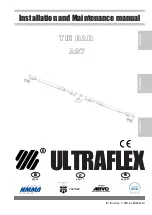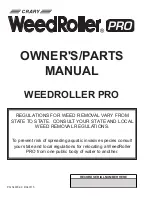
Maintenance
24
© Lutz-Jesco GmbH 2021
BA-22404-02-V03
Chlorine changeover unit
C 7520
Operating instructions
12 Maintenance
Products by Lutz-Jesco are manufactured to the highest quality stand-
ards and have a long service life. However, some parts are subject to op-
erational wear. This means that regular visual inspections are necessary
to ensure a long operating life. Regular maintenance will protect the de-
vice from operation interruptions.
DANGER
Mortal danger from electric shock!
Live parts can inflict fatal injuries.
ð
Before carrying out any maintenance work, always disconnect the
device from the power supply.
ð
Secure the system to prevent it from being switched on by accident.
DANGER
Danger to life from chlorine poisoning!
Do not carry out maintenance or any other work on the chlorinator until
the system has been decommissioned and all of the chlorine gas has
been removed from the lines. The failure to follow this instruction pre-
sents a significant risk of injury.
ð
Prior to any maintenance work, prepare the system in accordance
with section 12.3 „Preparing the system for maintenance“ on page
24.
PLEASE NOTE
Damage from corrosion
Water in chlorine carrying system components combines with chlorine
to form hydrochloric acid and leads to corrosion.
ð
After completing maintenance work, remove all the water residue
from the system before returning it to operation.
ð
Keep the connection of the contact vacuum meter closed so that
humidity cannot penetrate
12.1 Maintenance intervals
Subject the chlorinator to regular maintenance, to prevent malfunctions.
Perform the maintenance in the following intervals:
Interval
Maintenance
After 3 years
n
Cleaning the device
n
Replace all seals
n
Functional control
After 5 years
n
Replace the pressure gauge
Tab. 15: Maintenance intervals
i
In some cases, regional regulations may require shorter
maintenance intervals. Carry out maintenance before
recommissioning the system after a long period out of service.
Maintenance intervals not depend only on how frequently the
equipment is used. Chemical wear of rubber parts, for
example, begins with the initial medium contact and continues
irrespective of the usage.
12.2 Maintenance accessories
You do not require any special commodities or tools for maintenance.
Maintenance sets with spare parts are listed in section „Maintenance kit
for ball-valve“ on page 29.
12.3 Preparing the system for maintenance
Perform the following working steps:
1.
Close the valves of the chlorine tanks.
2.
Use the injector to suck off the remaining chlorine.
3.
If possible, operate the chlorine gas system for approximately five
minutes with nitrogen or dry compressed air.
4.
Switch off the injector.
ü
The system is prepared for maintenance.
12.4 Maintenance on the ball valve
Precondition for action:
ü
The system is prepared in accordance with section 12.3 „Preparing
the system for maintenance“ on page 24.
ü
The system is depressurized.
ü
The voltage supply has been switched off.












































